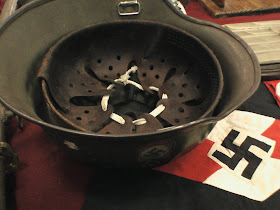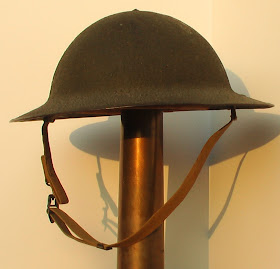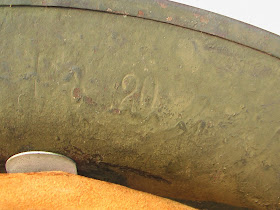If helmets could talk...would we even believe what they had to say?
Here is my U.S.Navy M1 helmet with radioman insignia. It was brought home in my seabag at the end of a four-year hitch in the Navy many (many) years ago.

Unlike other branches of the military, on a Navy ship in the 1960s and 70s one was not issued a helmet, one merely had ready access to a stack of helmets that would be worn during General Quarters or Battle Stations. The Radio compartments that I served in had such stacks, and this is one of those helmets that I may or may not have worn over the course of my time on the ship. This particular helmet is from the destroyer U.S.S. Higbee (DD-806) my last ship I served on, and, consequently, my last opportunity to grab "my" helmet before leaving the ship for the final time in July of 1974.

Many M1s, during the lifetime of their use, were marked by the sailors who wore them at some point. The "sparks" of a Radioman's rating badge reference the shower of sparks that were produced by the old open-ocillator telegraph keys of the old days. By the time I was in Morse code was seldom used anymore but the symbolism remained in our insignia.

These stacks of "ships company" helmets throughout the ship had probably been aboard for the life of the ship, which is why it seemed there were always more helmets than sailors as the crew strength for the Higbee during World War Two was considerably larger that that of 1973-74. Nonetheless, these old M1s represented (for those of us who were thinking about it) an unbroken line of continuity between us and our shipmates of earlier decades.

The liner of "my" helmet is a war-time Firestone...

as indicated by the distinctive "F" logo in the dome.

The shell itself, typically for USN helmets, is a Schleuter, and the front-joined rim seam indicates WWII production.

The swivel bails have the earlier bar-tacked chinstraps, this one looking pretty "salty".

With the dark gray liner this helmet is nearly complete save for the leather liner chinstrap.
I enjoyed much of my time aboard both of my destroyers mainly because of the great bunch of shipmates I was serving with. And here is a very short, very true story of those days, which I hope you enjoy.
 That's me, bottom row, centerOne of my favorite, and funniest, memories of my first ship, the destroyer USS DeHaven (DD-727), comes from a time when things in the Navy were not particularly jolly. The war in Vietnam were winding down for the U.S., the gap between civilians and service members was widening, and there seemed to be a growing hostility between the four-year enlistment sailors and the career men, also known as "the lifers".
That's me, bottom row, centerOne of my favorite, and funniest, memories of my first ship, the destroyer USS DeHaven (DD-727), comes from a time when things in the Navy were not particularly jolly. The war in Vietnam were winding down for the U.S., the gap between civilians and service members was widening, and there seemed to be a growing hostility between the four-year enlistment sailors and the career men, also known as "the lifers".
This was also a time when drug and alcohol abuse was rampant throughout the services, and the 727 was a microcosm of the Navy and many of its problems in those dreary days. That's the deep background to provide some context for this story.
Some time in 1972 we were tied up, as usual, along piers 17 and 18 out on the mole at Naval Station Long Beach (California). It was a typical duty evening on an in-port weekend.
I was the duty Radioman (RM3c) having a pretty laid-back evening. We didn't have the radio guard so I had little to do but read. I was still a new guy and was having only limited success making friends with guys in other divisions (remember being the "new guy"?).
Along about eight in the evening my boss, and a pretty good guy, the RM1 of the shack came zooming onto the messdecks with a battle lantern ...looking for me. My boss was the duty Master at Arms (the ship's policeman) that night, resplendent in his new style utilities (those dreadful duds with which they tried to replace the good old dungarees) and his dazzling MAA badge.
"Mannie" he said breathlessly, "come with me".
Now, I was a sailor who was always ready to oblige a shipmate, so without question or hesitation I followed my RM1 off the messdecks up to the radioshack. "What's up boss?" was my only question. He made a finger to the lips gesture to clue me to pipe down and scowled, and sniffed, at the overhead ventilation duct.
"Do you smell that shit?" he whispered. "That's 'green smoke', and it can only be coming from one place". A historical note: For some reason, there were those among the senior enlisted who referred to marijuana smoke and the smell thereof as "green smoke". I even met those who insisted that it was called that because the smoke of burning cannabis is emerald green. Obviously, they'd never imbibed themselves.
Back to the story. The RM1 moved his intent gaze to me and repeated "there's only one place that that smell can be coming from. Someone's smoking dope in OUR fanroom!". There was a fanroom just abaft the radioshack on the starboard side. Accessible only with a stepladder through a scuttle in the overhead, it was a space the RMs referred to as "the void" and it was where we stored our supply of teletype paper and tape. For inspection purposes it was the radio crew's property and responsibility. "Let's go!" hissed the RM1 as he handed me that battle lantern and pushed me out the door of the radio shack ahead of him. Had I been a cartoon character at that moment my word balloon would have said something like "buh, buh, buh...ahhh wait a second".
Off we went into the dark of the night, the RM1 becoming quite impatient with all of the noise I made as I clumsily followed him. "Quiet! or they'll know we're coming" he whispered. "That's, sort of the whole idea" I thought to myself.
We made our way to the main deck, me with the lantern and the RM1 armed with a rickety stepladder which he quietly set up beneath the scuttle. "Now get up there and bust those guys" he said to me. At that time I was choosing to believe it was merely a request rather than an order. "But boss," I protested, "these are guys that I have to live and work with, and I've got no beef with them, cause, y'know..." It was as if he hadn't heard me, like a fine hunting dog on the point he was intently staring at that overhead scuttle and just as intently pushing me up the ladder.
The "why me?" question was simply one of girth. Without commenting on the robust build of the RM1, I'll just note that at that time in my life my broadest dimension was my post-adolescent Adams apple: I was the logical choice to go through the scuttle and into the Babylon above. This was to be my show.
I was the logical choice to go through the scuttle and into the Babylon above. This was to be my show.
With my head pressed nearly sideways against the overhead as I wrestled with the dog-wheel I could hear indistinct murmuring coming from the space. As the dogs retracted, I slowly swung the hatch down, swallowed hard and poked my head up. The experience was unlike any I've had before or since. If one could stick ones head inside a bong at a frat-party, that might approximate the sensation I had. As my nostrils cleared the coaming of the hatch I became immediately aware of an all too familiar aroma...in spades! That was one very smoky space and because it was a fan room, that smoke was being communicated throughout quite a bit of the ship.
"I don't see anybody boss" was my very lame report. "Jeezus! use the lantern!" he shouted (the need for stealth was now past). I craned my head over and squeezed my arm and the battle lantern through. I snapped on the light, the beam of which became a ghostly and thick illumination of smoke. My head poking through the scuttle, eyes only inches above the deck, I slowly played the beam 360 degrees around the space level with my eyes.
That smoky beam revealed fully a dozen pairs of shoes; oxfords, boondockers, flipflops, all attached to pantlegs that extended up into the faceless gloom. The sound was that of breath being held by twelve shipmates caught red-handed (though all I saw was ankles).
"Well?" was the sharp one word question from below. Now, remember, I was a sailor who was always ready to oblige a shipmate, so again, without question or hesitation, and with great presence of mind I gave my report:
"They musta' just left boss. Nothing up here but teletype paper."
"Dammit!, we shoulda' come quicker!". Clearly disappointed at losing his quarry, he stomped off into the night looking for other crime to fight, leaving me to secure the void, the ladder, and the lantern.
I returned to the messdecks and my book and business as usual, being the new guy, trying to find my way on a ship where everybody else seemed to be friends with everybody else. Except that it was never business as usual again after that evening.
No sooner had I gotten settled in and resumed reading, than a mix of snipes and deck division types slid in next to me and one piped up: "So Gentile, you just got off Guam eh? Whatcha readin'?". And a lively, breezy bull-session began, of which I was a full partner. Eventually every one trailed off to hit the rack or relieve the watch. I realized that my status as the new guy was coming to a welcome end.
"What a great bunch of guys" I thought, "a great bunch of bleary-eyed guys who smell like they've been fighting a brush fire".
And the rest was pretty smooth sailing.
provenance:
accession number: MOAharm 195.v2
United States Navy M1 Helmet (Radioman)
Acquired 1974, USS Higbee (DD-806) Long Beach, California
Condition: good



























































